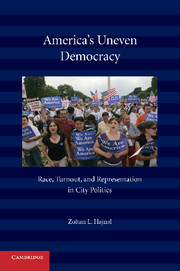Book contents
- Frontmatter
- Contents
- Acknowledgments
- America's Uneven Democracy
- Introduction
- 1 Where Turnout Should Matter
- 2 Turnout Could Matter at the Local Level
- 3 Winners and Losers in Mayoral Elections
- 4 Turnout and Representation on City Councils
- 5 Turnout and Local Government Spending Priorities
- 6 Raising Voter Turnout
- 7 The Broader Implications of Uneven Turnout
- Appendix
- Bibliography
- Index
4 - Turnout and Representation on City Councils
Published online by Cambridge University Press: 05 June 2012
- Frontmatter
- Contents
- Acknowledgments
- America's Uneven Democracy
- Introduction
- 1 Where Turnout Should Matter
- 2 Turnout Could Matter at the Local Level
- 3 Winners and Losers in Mayoral Elections
- 4 Turnout and Representation on City Councils
- 5 Turnout and Local Government Spending Priorities
- 6 Raising Voter Turnout
- 7 The Broader Implications of Uneven Turnout
- Appendix
- Bibliography
- Index
Summary
The last chapter illustrated the broad potential of voter turnout to alter outcomes in American cities. If America's racial and ethnic groups all turned out to vote at the same rate, winners in urban politics would likely look very different from those we see today. The results of the last chapter are therefore an important benchmark that indicates the degree to which low turnout is hurting America's racial and ethnic minorities.
This chapter asks a second but no less critical question about the effects of turnout. The goal of this chapter is to assess how much real-world changes in turnout across cities and elections affect outcomes. Rather than asking what the world might look like if different racial and ethnic groups all turned out at the same rate, we ask how different the world looks in places where more voters do show up at the polls. Do cities with higher, more even turnout experience different outcomes from cities with lower turnout? Thus, the chapter provides an account of how much turnout matters from city to city and day to day.
This chapter advances our understanding of the impact of turnout in American democracy in two other important ways. First, it shifts the focus from the mayoralty to city council representation. Most American cities have a city council/city manager form of government where the council – rather than the mayor – is the highest elected body (Hajnal and Lewis 2003).
- Type
- Chapter
- Information
- America's Uneven DemocracyRace, Turnout, and Representation in City Politics, pp. 70 - 100Publisher: Cambridge University PressPrint publication year: 2009



